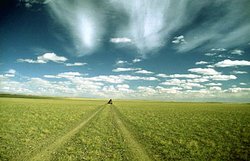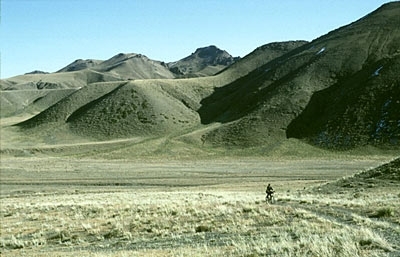Eastern Gobi desert steppe
Moving from China’s eastern coast toward the center of Asia, one encounters increasingly arid landscapes. Beyond the mountains that lie inland from China’s coastal plain, semi-arid steppe gives way to the Central Asian deserts, called gobis. Here the driest places support desert wildlife, but few people. The peripheral steppe regions, however, receive a flush of grass during summer that allows the areas to be inhabited, if sparsely, by herders whose goats and horses feed on the region’s meager productivity.
Contents
Location and General Description
The Eastern Gobi Desert Steppe extends from the Inner Mongolian Plateau (China), situated at 1,000 to 1,500 meters (m) elevation, northward into Mongolia. It is a broad ecotone. Boundaries are determined to the east and north by the relatively moist grasslands of Mongolia and Manchuria, and to the west and south by the extensive semi-deserts of the Alashan Plateau. This ecoregion includes the Yin Shan, a mountain range that rises to an elevation of 1,500 to 2,200 m, and many low-lying areas with salt pans and small ponds. Although the region appears rather desolate, it provides potential habitat for many wildlife species and a human population of semi-nomadic herders.
The climate here is continental. Summers are warm to hot, depending on elevation, and winters are intensely cold. Winter conditions are harsher here than other parts of China at similar altitude and latitude because there are no mountains to shelter the region from cold northerly winds. The mean annual temperature varies from -2 to -6oC, with January mean temperatures of -20 to -28oC. Annual precipitation here is about 100 to 150 millimeters (mm), although total precipitation varies considerably from one year to the next. Most of this precipitation falls during summer.
Vegetation tends to be homogenous across vast areas of the Eastern Gobi Desert Steppe and distinct from the vegetation of grasslands to the east and deserts to the west. It consists of drought-adapted shrubs and thinly distributed low grasses. Dominant shrubs include two Caragana species (C. bungei and C. leucocephala). This shrubby legume is also dominant over much of the Tibetan Plateau in the transitional area between the cold, moist grasslands of the east and the cold deserts of the western plateau. Other shrubs include gray sparrow’s saltwort (Salsola passerina), gray sagebrush (Artemisia xerophytics), Potaninia mongolica, and Nitraria sibirica. Low grasses include needle grass (Stipa gobica and S. glareosa) and bridlegrass (Cleistogenes soongorica).
Biodiversity Features
 Gobi desert, Mongolia. (Photograph by Hessberg and Schulze)
Gobi desert, Mongolia. (Photograph by Hessberg and Schulze) Mammals characteristic of the Eastern Gobi Desert Steppe include Asian wild ass (Equus hemionus), Saiga antelope (Saiga tartarica mongolica), black-tailed gazelle (Gazella subgutturosa), marbled polecat (Vormela peregusna), and several species of Jerboa (Zapodidae). Jerboas comprise a small family of mammals that are adapted to burrowing and jumping in sandy [[habitat]s]. Their hind legs are as much as five times the length of their forelegs. They have long, flexible tails, and are capable of jumping up to 3 m. Several species are endemic to the deserts of Central Asia, and include the long-eared jerboa (Euchoreutus naso), Kozlov's pygmy jerboa (Salpingotus kozlovi), Mongolian jerboa (Stylodipus andewsi), and Gobi jerboa (Allactaga bullata). The mountains of this ecoregion include potential habitat for snow leopards (Uncia uncia) although it is uncertain whether any snow leopards survive here.
Birds characteristic of the desert steppe include Houbara bustard (Chlamydotis undulata), Pallas sandgrouse (Syrrhaptes paradoxus), Henderson's ground jay (Podoces hendersoni), greater plover (Charadrius leschenaultii), Mongolian desert finch (Bucanetes mongolicus), chukar (Alectoris chukar), lammergeier (Gypaetus barbatus), and Cinereous vulture (Aegypius monachus).
In general, the portion of this ecoregion that lies in Mongolian has been less heavily influenced by people and supports more intact wildlife [[population]s] than does the portion located within China.
Current Status
Desert steppe vegetation is susceptible to damage caused by trampling (livestock or off-road vehicles) and overgrazing, particularly by goats. Because the Eastern Gobi Desert steppes receive more precipitation and are more productive than the desert regions to the west, this ecoregion receives a greater human impact. Mongolia’s system of national parks and nature reserves does not cover this area adequately, as most of the protected areas are located in the most arid, [[mountain]ous] places or in the taiga of northern Mongolia. The portion of this ecoregion that lies within China is similarly devoid of nature protection areas, although de facto wildlands do exist here because the area is so marginal.
Types and Severity of Threats
In recent years, the number of goats raised on the grasslands has increased considerably due to the high prices for cashmere wool, which comes from goats. Because goats eat a wider range of plant species, forage more aggressively and tend to consume the whole plant, this trend has contributed to degradation of the grasslands over a widespread area.
In Mongolia, economic trends of livestock privatization and the collapse of the urban economy have caused people to return to rural lifestyles, a movement contrary to the global trend toward urbanization. As a result, the number of herdsmen in Mongolia is reported to have tripled in the past decade to more than 450,000 and the number of livestock has increased by 30 percent.
Justification of Ecoregion Delineation
This ecoregion represents a transitional zone between Mongolian-Manchurian grassland and Alashan Plateau semi-desert. Shrub semi-desert cover the northern part of the region transitioning into more xerophytic communities on sandy, rubble soils to the south. The boundary is based on CVMCC (1979) Vegetation Map of China classes of desert steppe (45,46, 47). This is comparable to the southwestern section of the Mongolian steppe biogeographic subunit in the Mongolian-Manchurian Desert according to Mackinnon et al. (1996).
Additional Information on this Ecoregion
- For a shorter summary of this entry, see the WWF WildWorld profile of this ecoregion.
- To see the species that live in this ecoregion, including images and threat levels, see the WWF Wildfinder description of this ecoregion.
- World Wildlife Fund Homepage
Further Reading
- Finch, C., editor. 1999. Mongolia's wild heritage. Mongolia Ministry for Nature and Environment, UNDP, GEF and WWF. Avery Press, Boulder.
- Government of Mongolia. 1996. Biodiversity conservation action plan for Mongolia.
- Hilbig, W. 1995. The vegetation of Mongolia. SPB Academic Publishing, Amsterdam.
- Laidler, L., and K. Laidler. 1996. China’s threatened wildlife. Blandford, London. .
- MacDonald, D., editor. 1999. The Encyclopedia of mammals. Barnes and Noble Books, New York. .
- MacKinnon, J. 1996. Wild China. The MIT Press, Cambridge. .
- MacKinnon, J., M. Sha, C. Cheung, G. Carey, Z. Xiang, and D. Melville. 1996. A biodiversity review of China. Worldwide Fund for Nature (WWF) International, Hong Kong.
- Schaller, G.B. 1998. Wildlife of the Tibetan Steppe. The University of Chicago Press, Chicago. .
- Zhao J., Z. Guangmei, W. Huadong, and X. Jialin. 1990. The natural history of China. McGraw Hill Publishing Company, New York. .
| Disclaimer: This article is taken wholly from, or contains information that was originally published by, the World Wildlife Fund. Topic editors and authors for the Encyclopedia of Earth may have edited its content or added new information. The use of information from the World Wildlife Fund should not be construed as support for or endorsement by that organization for any new information added by EoE personnel, or for any editing of the original content. |

